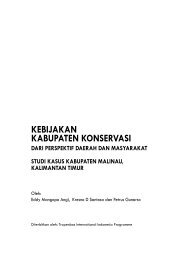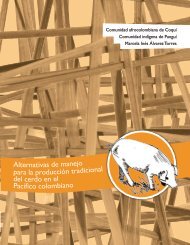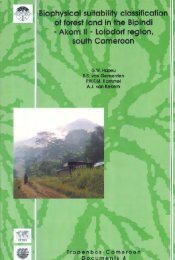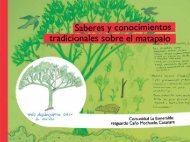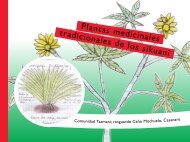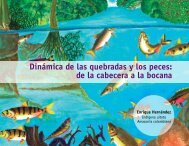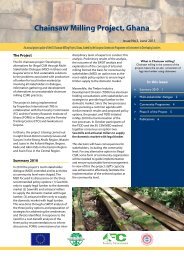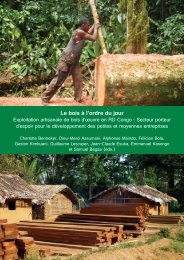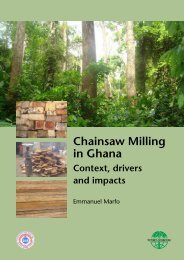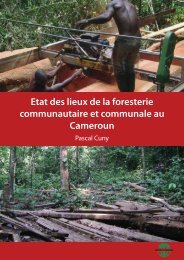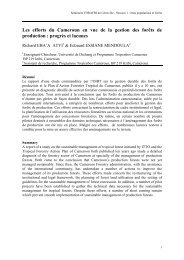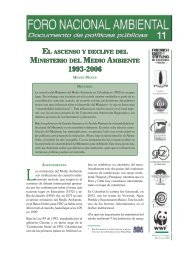Download the publication - Tropenbos International
Download the publication - Tropenbos International
Download the publication - Tropenbos International
Create successful ePaper yourself
Turn your PDF publications into a flip-book with our unique Google optimized e-Paper software.
1.1. BACKGROUND<br />
General introduction<br />
During <strong>the</strong> last few decades, deforestation in tropical rain forest areas has<br />
accelerated at an alarming rate. Extensive areas of forest are being cleared every<br />
year and <strong>the</strong>re is no reason to believe that this disastrous process will stop or even<br />
reduce in <strong>the</strong> near future. It has been estimated that more than 11 million hectares of<br />
forest have been cleared in <strong>the</strong> world between 1986-1990 of which 5 millions have<br />
become fallow (FAO, 1993). Fur<strong>the</strong>rmore, some 15-20% of species is likely to<br />
become extinct even before <strong>the</strong>y are known to science (Davis et al., 1994). With <strong>the</strong><br />
growing awareness of <strong>the</strong> problem, tropical rain forest biodiversity is of great<br />
concern and its conservation has become an issue of increasing priority, though little<br />
has been done to counter <strong>the</strong> rapid disappearance of <strong>the</strong>se rich ecosystems. The rain<br />
forest in Cameroon covers about 175,000 km²representing about 37% of <strong>the</strong><br />
national territory (Gartlan, 1992). Uncontrolled logging and land conversion for<br />
agriculture are leading to forest degradation and deforestation. Estimates put <strong>the</strong><br />
remaining areas of forest at about 160,000 km² with a fur<strong>the</strong>r 60,000 km² currently<br />
under concession to timber companies (Sunderland et al., 1997)<br />
The Campo-Ma’an rain forest in south-western Cameroon covers about 7700 km²<br />
and is situated in <strong>the</strong> middle of <strong>the</strong> Biafran rain forest belt that extends from<br />
Sou<strong>the</strong>ast Nigeria to Gabon and <strong>the</strong> Mayombe area in Congo. The site is unique,<br />
combining many vegetation types with species of high conservation priorities such<br />
as endemic, rare, new and threatened plant species. It contains about 114 endemic<br />
species, 29 of which are only known from <strong>the</strong> area, 29 only occur in <strong>the</strong><br />
southwestern part of Cameroon, and 56 are near endemics that also occur in o<strong>the</strong>r<br />
parts of Cameroon (Chapter 5). The site is also known for its rich fauna with 4<br />
endemic fish species and 2 endemic bat species (Vivien, 1991; Djama, 2001; de<br />
Kam et al., 2002). In addition, <strong>the</strong>re are about 300 bird species of which 24 are rare<br />
or endangered (Languy & Demey, 2000). Thirteen threatened mammal species were<br />
listed in IUCN (2002), and up to half of <strong>the</strong> total mammal species found in<br />
Cameroon and two-thirds of those found in dense forest are recorded in <strong>the</strong> area<br />
(Vivien, 1991; Mat<strong>the</strong>ws & Mat<strong>the</strong>ws, 2000). The explanation for this high<br />
incidence of endemism and richness might stem partly from <strong>the</strong> fact that <strong>the</strong> site is<br />
part of a series of postulated rain forest refuge areas in Central and West Africa<br />
(Hamilton, 1982; Maley, 1987 & 1989; and Sosef, 1994).<br />
The conservation value of <strong>the</strong> Campo-Ma’an forest is high at local, national,<br />
regional and global levels. The area is recognised to be an important site within <strong>the</strong><br />
Guineo-Congolian Regional Centre of Endemism (White, 1979 & 1983). However,<br />
despite its great biological importance, <strong>the</strong> Campo-Ma’an rain forest has suffered<br />
and continues to suffer from intense human pressure that has led to <strong>the</strong> degradation<br />
of most of <strong>the</strong> forest along <strong>the</strong> coast and <strong>the</strong> lowland forest around settlements. The<br />
main conservation effort so far has been <strong>the</strong> creation of <strong>the</strong> Campo Faunal Reserve<br />
in 1932 to protect its rich fauna, and <strong>the</strong> Ma’an Production Reserve in 1980 to<br />
protect populations of <strong>the</strong> economically important timber species Aucoumea<br />
klaineana (Okoumé). These two reserves are currently merged into a single<br />
Technical Operational Unit (TOU) that was created in August 1999. Later on, <strong>the</strong><br />
Campo-Ma’an National Park was created within this TOU in January 2000. So far,<br />
3



